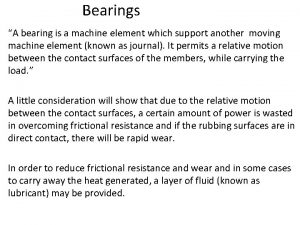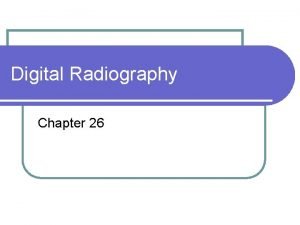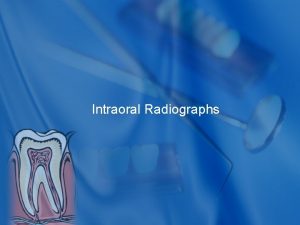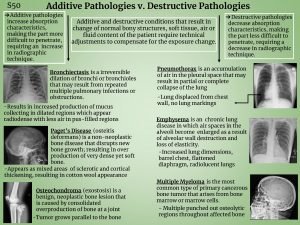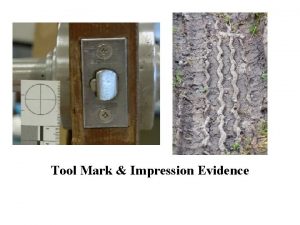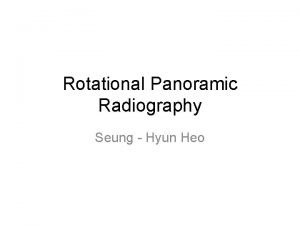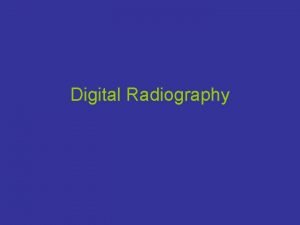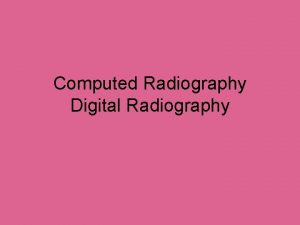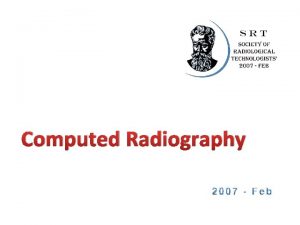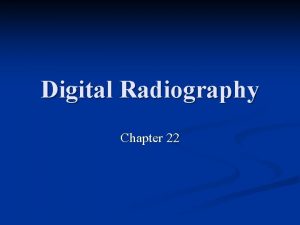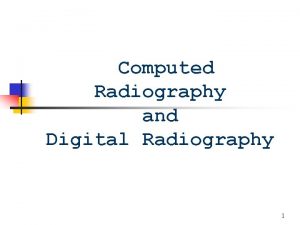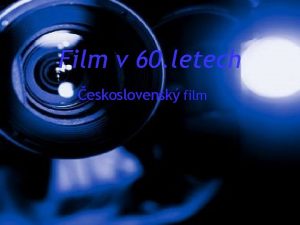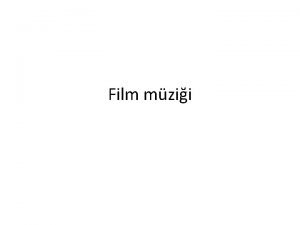RADIOGRAPHY USING FILM AND DIGITAL RADIOGRAPHY Some factors


































- Slides: 34

RADIOGRAPHY USING FILM AND DIGITAL RADIOGRAPHY Some factors to consider when choosing which technique to use

DR uses Digital Detector Arrays (DDAs) or Linear Arrays to obtain radiographic images DDAs work by converting X-rays into digital data without the need for a separate process to extract the data from the media. The X-rays are either converted directly into electrical signals (direct panels) or capture the light generated by a scintillation layer when X-rays hit them (indirect panels). DDAs are near to 'real time'. DR –WHAT IT IS AND HOW IT WORKS

Image quality Interpretation Factors Operator Training Safety Specifications Commercial Considerations FACTORS AFFECTING CHOICE

RESOLUTION TOTAL UNSHARPNESS CONTRAST NOISE & SIGNAL: NOISE RATIO DYNAMIC RANGE – LATITUDE DQE SENSITIVITY IMAGE SYSTEM FAULTS RADIOGRAPHIC IMAGE QUALITY - WHAT IT IS; COMPARISON OF FILM AND DDAS

The ability to differentiate two spatially separated features; when resolution is adequate the features appear separate; where resolution is poor, the features merge together. Basic resolution is measured with a duplex IQI placed directly on the detecting medium; it is however unnecessary to measure basic resolution when using film because it is almost always better than the smallest wire pairs on the current duplex IQIs. There is no doubt that the basic resolution of film is much better than the basic resolution of DDAs. . RESOLUTION

A combination of resolution and geometric unsharpness, the total unsharpness measures the 'blurriness' of images. Formula in ASTM E 2698 It is measured with the same tool as basic resolution, used at the object-to-film (or objectto-detector) distance. There is little point in having a good basic resolution if the geometric unsharpness is poor because all the resolution will give you is a more detailed study of the blur. Typical maximum unsharpness requirements for thinner components (e. g. 3 mm Steel) are: ASME V Art. 2 : 0. 25 mm ASTM E 1416: 0. 5 mm ISO 17636 Class A: 0. 3 mm ISO 17636 Class B: 0. 15 mm TOTAL UNSHARPNESS

Contrast is the difference between the density (or grey levels) of two different thicknesses. It is often measured for a thickness change of 2%, but there is no set standard. When contrast is high it is easy to differentiate between slight changes in thickness. In general, contrast is higher for DDAs than for film. CONTRAST

Source of Noise Mitigation Object surface Polish surface Object grain structure Change k. V Scatter Control scatter Granularity (stochastic noise) from random nature of radiation Get more samples of photons from finer grain film (or slower phosphor screens) / Multiple exposures from DDAs NOISE & SIGNAL : NOISE RATIO

EFFECTS OF NOISE – 2 D 4 IMAGES

EFFECTS OF NOISE – 4 WELD IMAGES

EFFECTS OF NOISE – 4 IQI IMAGES

EFFECTS OF NOISE – IQI PROFILES

Film: Relative dose from 500 to 2000 (density 2. 0 to 4. 0) DR: Relative dose from 10 to 10000 (Intensity 0. 6 to 4. 0) (from Industrial Radiography – image forming techniques by GE Inspection Technologies 2008) Effect is that a much greater range of thicknesses can be effectively examined at the same time DYNAMIC RANGE – LATITUDE

Image quality in all radiographic image systems can be improved by extending the exposure time. Detective Quantum Efficiency is a measure used to compare efficiency of different systems at a particular spatial frequency (resolution). Calculations are difficult and need a lot of resources, therefore used in some medical applications where patient dose is always important, but not in NDT specifications Formal definition is the ratio of the square of the input signal : noise ratio to the square of the output signal : noise ratio The high signal: noise ratios achieved by DDAs with low dose (when compared to film) mean that, provided the required spatial frequency is achieved, DR has a very much better DQE than film. DQE

In NDT, sensitivity is assessed either by wire-type IQIs, or using holes in plaque or step IQIs. When using DDAs, wires considerably smaller than the pixel size can be detected when signal: noise ratio is adequate This is due to the pixel measuring the reduction in radiation hitting the detector, even when the wire does not cover all the pixel. All wires smaller than the detected pixel size will all display with the width of the pixels. SENSITIVITY

IQI IMAGES

Film: Dirt, scratches, processing marks; all random in nature DDAs: Dead pixels, bright pixels, underperforming pixels, Cluster Kernel Pixels. Specifications for film radiography are often subjective (e. g. ‘artifacts shall not interfere with interpretation of relevant flaws’). Specifications for digital radiography are able to be more objective (e. g. ‘there shall be no CKPs in the area of interest’). IMAGE SYSTEM FAULTS

Reading and Interpretation – Equipment & Tools. Operator effectiveness Operator knowledge and training Safety Test Specifications Acceptance Standards Flexibility of Application OTHER RADIOGRAPHIC CONSIDERATIONS

Equipment Film: Illuminators, magnifiers, densitometers. DDAs: Monitors and Workstations Available tools Film: Varying masking, adjustable brightness, scale rules, comparators, measuring magnifiers DDAs: Varying magnification, adjustable brightness, adjustable contrast, digital filters, automated dimension measuring tools, profile tools (for analysing grey levels), statistical tools and annotation tools. READING AND INTERPRETATION

Radiographers: The wide latitude of DR panels and instant image review reduce the need for re-shoots. Modern acquisition software guides the radiographer to make exposures optimised to the required quality. Eg I-See Pro and The Teledyne Go-scan. Interpreters: The relatively relaxed, low fatigue nature of viewing on monitors, coupled with the wide range of tools available, reduces errors and allows greater efficiency. OPERATOR EFFECTIVENESS

RADIOGRAPHER INTERFACE – I-SEE PRO

RADIOGRAPHER INTERFACE – GOSCAN

At Level 1, the easier image acquisition and instant review suggests less skill is required. At Level 2, the deeper knowledge of image quality needed tends to increase the training syllabus for DR over FR, but it is largely similar to film radiography. At Level 3, the understanding of workstations & software tools, monitors, DDA panel properties, image analysis and quality parameters, is somewhat broader than the equivalent film radiography; however, I believe that Level 3 s, whether in film or digital, should have a good knowledge of all the major radiographic techniques. OPERATOR KNOWLEDGE

Radiography always hazards that need to be properly addressed. Safety procedures should always be followed. The radiation used for each exposure is significantly less for DR than for film, so as long as safety procedures are followed, the risk using DR is likely to be be significantly less than film radiography. SAFETY

Film radiography has a full range of international specifications available for aerospace, castings and welds, for both ISO standards and American standards. Standards for digital radiography have been catching up, with a full range of SAE aerospace standards now available, well established requirements in ASME B&PV Code V, and ISO 17636 Part 2 for welds. The main specifications currently missing are a BS specification for castings equivalent to BS EN 12681 and an ISO specification for General Rules equivalent to BS EN ISO 5579. TEST SPECIFICATIONS

Available: ASTM E 2422 Digital reference images for inspection of aluminium castings (E 155 for film) ASTM E 2660 Digital reference images for investment steel castings for aerospace applications (E 192 for film) ASTM E 2669 Digital reference images for titanium castings (E 1320 for film) ASTM E 2868 Digital reference images for Steel Castings up to 2” (E 446 for film) ASTM E 2869 Digital reference images for magnesium castings (E 155 for film) ASTM E 2973 Digital reference images for inspection of aluminum and magnesium die castings (E 505 for film) In preparation: Electronic reference images for welds are currently being worked on, with the IIW ISO 5817 weld catalogue already available for Android (1500 Eur with an Android tablet). ACCEPTANCE STANDARDS

Films operate from 20 k. V to 10 Mv and more, with only a change of intensifying screens needed. For best results, DDAs require matching to application – resolution, energy range, image rates. Films and cassettes can be cut to shape and curved to follow a profile Current DDA technologies are rigid, relatively fragile and have a significant thickness. FLEXIBILITY OF APPLICATION

Capital costs - DDAs Panel(s) Data networks Acquisition systems and software Review systems, monitors and software Image storage, archiving and databases Capital costs - Film Cassettes and screens Film processors Darkroom Chemical storage COMMERCIAL CONSIDERATIONS

DDA Consumable Costs Amortisation of DDAs and Systems Software maintenance contracts Digital Storage, backup and security Film Consumable costs Processing chemical costs Used chemical disposal Amortisation of processing equipment, cassettes and screens. Film storage and indexing COMMERCIAL CONSIDERATIONS

Training costs It is likely that training costs for DR will be similar to FR. It is also likely that transferring from FR to DR (or vice-versa) will be significantly less than full training. COMMERCIAL CONSIDERATIONS

Exposure times Typical exposure times for DR and Film at 500 mm FFD/FDD: Film ASME V: 4 m. A. mins ISO 17636 Class B: 12 m. A. mins DR Speed of single image production Typical processing times for DR and Film: Film 8 minutes processor + ½ minute cassette reloading. DDA 1 second ASME V: 6 m. A. seconds ISO 17636 Class B: 1. 5 m. A. mins COMMERCIAL CONSIDERATIONS

Physical considerations Handling needs, size, flexibility, access, power requirements Possibility of automation Environmental costs COMMERCIAL CONSIDERATIONS

Film radiography Digital Radiography with DDAs Well established Still relatively new technology Relatively low capital costs High capital costs are now reducing, with systems available for less than £ 50, 000 High consumable costs Low consumable costs Fully supported by training and certification Training and certification still being developed, PCN due next year Applicable to all thicknesses Magnification needed for thickness less than 1. 5 mm Flexible in application, from tiny diodes to heavy-walled castings Panels need to be matched to application. Unsuitable for automation SUMMARY

For many applications, DR is now a viable and justifiable technology both for both commercial and quality reasons Weld radiography using DDAs for penetrated thickness greater than 1. 5 mm is now a real alternative to film, both in the laboratory and particularly on-site Film radiography will remain a better alternative to DR in applications such as thin sections and where shaped cassettes are needed, as well as for reasons such as lack of relevant specifications, excessive capital costs or lack of suitably qualified staff. CONCLUSION
 What are the two areas in dark room? *
What are the two areas in dark room? * Slipper or guide bearing
Slipper or guide bearing What is contact force
What is contact force Some trust in chariots and some in horses song
Some trust in chariots and some in horses song Chapter 39 digital imaging film and radiographs
Chapter 39 digital imaging film and radiographs Chapter 39 digital imaging film and radiographs
Chapter 39 digital imaging film and radiographs Sometimes you win some sometimes you lose some
Sometimes you win some sometimes you lose some They say sometimes you win some
They say sometimes you win some Ice cream: countable or uncountable
Ice cream: countable or uncountable Some say the world will end in fire some say in ice
Some say the world will end in fire some say in ice Some say the world will end in fire some say in ice
Some say the world will end in fire some say in ice Is dirt abiotic or biotic
Is dirt abiotic or biotic Abiotic vs biotic factors
Abiotic vs biotic factors Abiotic vs biotic factors
Abiotic vs biotic factors Dactors of 8
Dactors of 8 Common factors of 10 and 20
Common factors of 10 and 20 Gcf of 25 and 30
Gcf of 25 and 30 Film marketing guide
Film marketing guide Oid and magnification
Oid and magnification Soot and whitewash radiography
Soot and whitewash radiography Additive and subtractive pathology in all body system
Additive and subtractive pathology in all body system 4 factors that influence communication
4 factors that influence communication Some factors that personalize our footwear include:
Some factors that personalize our footwear include: Biotic vs abiotic
Biotic vs abiotic Some factors that personalize our footwear include:
Some factors that personalize our footwear include: Prime factors worksheets
Prime factors worksheets Digital markets and digital goods
Digital markets and digital goods Complete the following sentences using some or any
Complete the following sentences using some or any Some people often say that using
Some people often say that using People often say
People often say Exercise some any no
Exercise some any no Site vs. situation
Site vs. situation Is a raspberry bush biotic or abiotic
Is a raspberry bush biotic or abiotic Site vs situation examples
Site vs situation examples Focal trough in panoramic radiography
Focal trough in panoramic radiography

